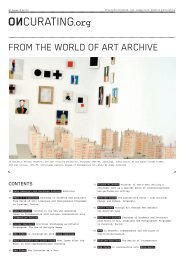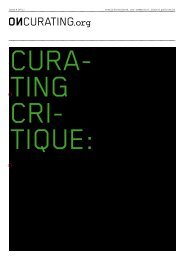You also want an ePaper? Increase the reach of your titles
YUMPU automatically turns print PDFs into web optimized ePapers that Google loves.
052 Issue # 11/11 : PublIc Issues<br />
Oda Projesi plays with alternative forms of representation<br />
also in its exhibition works that are made to be displayed<br />
in traditional art spaces such <strong>as</strong> museums, galleries, and<br />
biennials. In the exhibition works, Oda Projesi changes its<br />
artistic strategy, remaining within the space of the art<br />
institution and bringing into space things from the outside.<br />
For instance, a shanty, an illegitimately produced building<br />
that does not deserve to be called proper architecture<br />
due to its precarious existence is constructed by workers<br />
(hired by the art collective) in the backyard of a biennial<br />
venue, the legitimate site for art.<br />
Alternatively, in some other works, the art collective si-<br />
tuates itself inside the art institution while simultaneous-<br />
ly extending its artwork towards the outside. An example<br />
of this w<strong>as</strong> Oda Projesi's contribution to the exhibition<br />
becoming a Place, curated by V<strong>as</strong>ıf Kortun in 2001 3 (Açıkkol<br />
2001). becoming a Place took place at Proje 4L, a museum<br />
of contemporary art located in the middle of a low-income<br />
neighborhood of run-down apartment buildings, <strong>as</strong> well <strong>as</strong><br />
near a business district full of high-rise business blocks<br />
with glossy facades. Oda Projesi had a poster on the wall<br />
of the gallery space that directed the museum visitors<br />
to another address in the neighborhood – that of an apart-<br />
ment rented by Oda Projesi and turned into a space for<br />
various events from home visits to discussions on art. In<br />
the c<strong>as</strong>e of Oda Projesi's contribution to the exhibit,<br />
this apartment w<strong>as</strong> in the process of becoming a place <strong>as</strong><br />
it w<strong>as</strong> constantly being filled with people and activities.<br />
A handout produced by Oda Projesi reads: "Spatial practices<br />
taking place in a specific place are what make it exist<br />
and give it its shape" (Oda Projesi Archives 2005). 4 The<br />
stuff of the situational works in Galata is this process<br />
of activation. Galata works, in this sense, are spatia-<br />
lizing actions that animate the social dynamics embedded<br />
in established places and transform them into political<br />
spaces of representation. The inhabitants actively partici-<br />
pate in the making of the social space, be it their own<br />
apartments or the courtyard. In the situational works, then,<br />
the concrete lived experiences of the project participants<br />
turn space from an inert thing, a being in and of itself,<br />
into a fluid and alive, thereby becoming process.<br />
The conception of space <strong>as</strong> a becoming process rather than<br />
a being <strong>as</strong> such is reminiscent of Henri Lefebvre's understanding<br />
of the production of space (Lefebvre 1991a).<br />
Considering space no longer <strong>as</strong> a thing in itself, a con-<br />
tainer in which things are located or practices take<br />
place, Lefebvre shifts the emph<strong>as</strong>is from space solely <strong>as</strong><br />
an object to the spatiality of social life. Just <strong>as</strong> Marx,<br />
who made the conceptual and political shift from things in<br />
exchange to social relations of production, Henri Lefebvre<br />
worked through a shift from things in space to the pro-<br />
duction of space (Lefebvre 1991a; Merrifield 1995). Lefebvre<br />
opens his spatial thought to the unsettling effects of<br />
rethinking the everyday and its instabilities; and thus<br />
one of the major buttresses of his spatial thought is<br />
the becoming quality of space (Lefebvre 2006, 2002, 1991b).<br />
For Lefebvre, space is a process; it is fluid and alive.<br />
It is not a dead or inert thing; it is not merely a<br />
physical container (Lefebvre 1991a). Thus space is always<br />
becoming, not a being <strong>as</strong> such. Lefebvre's work troubles<br />
the dualistic understanding of space restricted to its use<br />
and exchange values and to a merely causal (determineddetermining)<br />
relation between the two. Combining his work<br />
on space with a critique of everyday life, Lefebvre ele-<br />
vates lived experience to the status of a critical con-<br />
cept in rethinking the production of space (Lefebvre 1991a,<br />
2002; Kaplan & Ross 1987). This move, in turn, leads<br />
3<br />
The art collec-<br />
tive employed this<br />
strategy also in<br />
some other site-<br />
specific projects.<br />
In Riem, Munich,<br />
for instance, Oda<br />
Projesi members<br />
were artists in<br />
residence, and the<br />
center of opera-<br />
tion w<strong>as</strong> Kunst-<br />
halle Riem. Yet<br />
the artwork exten-<br />
ded into the<br />
neighborhood and<br />
made actual living<br />
spaces—both in-<br />
doors and outdoors<br />
– parts of the<br />
artworks (Oda<br />
Projesi Archives<br />
2005).<br />
4<br />
The original is<br />
in Turkish, the<br />
translation is<br />
mine.<br />
5<br />
For a more de-<br />
tailed discussion<br />
of Lefebvre's<br />
trialectical<br />
understanding of<br />
the production of<br />
space and my<br />
update on it with<br />
reference to<br />
Michael Hardt and<br />
Antonio Negri,<br />
ple<strong>as</strong>e see my un-<br />
published Ph.D.<br />
thesis available<br />
online in the<br />
University of<br />
Rochester Digital<br />
Archives: http://<br />
hdl.handle.<br />
net/1802/6201.<br />
Lefebvre to expand his spatial thought and to develop a<br />
spatial trialectics. 5 Seeking to exceed the dualism between<br />
use and exchange values of space inherent to normative<br />
definitions of the capitalist production of space, Lefebvre<br />
draws attention to a third level at which space can be<br />
understood. He calls this third level lived/social space<br />
or representational space; and he argues that the relation-<br />
ship between space and politics can be understood only<br />
if this third level is also included in the analysis of<br />
the production of space (Lefebvre 1991a, Merrifield 1995).<br />
In its artistic commentary on the production of space and<br />
spatial practices, Oda Projesi relies on a definition of<br />
representational space akin to that in Lefebvre's trialectics.<br />
For Lefebvre, representational/lived/social spaces<br />
are political spaces; and their politics is colored by<br />
the social practices that they are made up of. Similarly,<br />
the art collective explores the politics of the userinhabitants'<br />
spatial practices in Istanbul. In Oda Projesi's<br />
projects, everyday spatial interventions by the inhabi-<br />
tants in their immediate urban environments appear <strong>as</strong><br />
integral to the production of space in the city. In other<br />
words, just like practices of urban designers, decisions<br />
of the state and real estate developers, processes of<br />
gentrification and large-scale urban regeneration projects,<br />
these minuscule interventions that are relatively difficult-<br />
to-name should nonetheless be recognized <strong>as</strong> practices<br />
and processes that play roles in giving shape and color to<br />
urban space.<br />
Oda Projesi's work can be seen <strong>as</strong> one among many contemporary<br />
art practices that have recently been explored by<br />
critics and theorists <strong>as</strong> suggestive of an emerging rubric<br />
in the history of art. These practices go by a variety<br />
of names such <strong>as</strong> collaborative, relational, socially/po-<br />
litically engaged, situationist, or new genre public art.<br />
There is an ongoing discussion on the definition of this<br />
new rubric which comprises multiple discourses. Suzanne<br />
Lacy situates some of these practices within the tradition<br />
of public art, and thus calls them "the new genre public<br />
art" (Lacy 1995). While Miwon Kwon rethinks these practices<br />
in terms of rethinking site-specificity with regard to<br />
locational identity (Kwon 2002; Demos 2003), Claire Doherty<br />
calls them the new situationists with reference to the<br />
interventionism of the Situational International of the<br />
1960s (Doherty 2004). Carlos B<strong>as</strong>ualdo and Reinaldo Laddaga<br />
argue that this new rubric can be defined <strong>as</strong> the politically<br />
engaged art of the age of globalization dedicated to<br />
social change through the creation of experimental communities<br />
(B<strong>as</strong>ualdo & Laddaga 2004). L<strong>as</strong>t but not le<strong>as</strong>t


![Download as PDF [10.6 MB]](https://img.yumpu.com/4266533/52/500x640/download-as-pdf-106-mb.jpg)

